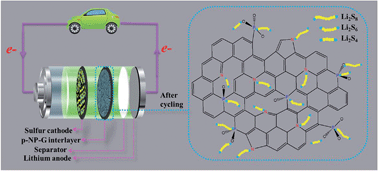A porous nitrogen and phosphorous dual doped graphene blocking layer for high performance Li–S batteries†
Abstract
Conductive confinement of sulfur and polysulfides via carbonaceous blocking layers can simultaneously address the issues of low conductivity, volume expansion of sulfur during the charge/discharge process and the polysulfide shuttling effect in lithium–sulfur (Li–S) batteries. Herein, a conductive and porous nitrogen and phosphorus dual doped graphene (p-NP-G) blocking layer is prepared via a thermal annealing and subsequent hydrothermal reaction route. The doping levels of N and P in p-NP-G as measured by X-ray photoelectron spectroscopy are ca. 4.38% and ca. 1.93%, respectively. The dual doped blocking layer exhibits higher conductivity than N or P single doped blocking layers. More importantly, density functional theory (DFT) calculations demonstrate that P atoms and –P–O groups in the p-NP-G layer offer stronger adsorption of polysulfides than the N species. The electrochemical evaluation results illustrate that the p-NP-G blocking layer can deliver superior initial capacity (1158.3 mA h g−1 at a current density of 1C), excellent rate capability (633.7 mA h g−1 at 2C), and satisfactory cycling stability (ca. 0.09% capacity decay per cycle), which are better than those of the N or P single doped graphene. This work suggests that this synergetic combination of conductive and adsorptive confinement strategies induced by the multi-heteroatom doping scheme is a promising approach for developing high performance Li–S batteries.


 Please wait while we load your content...
Please wait while we load your content...